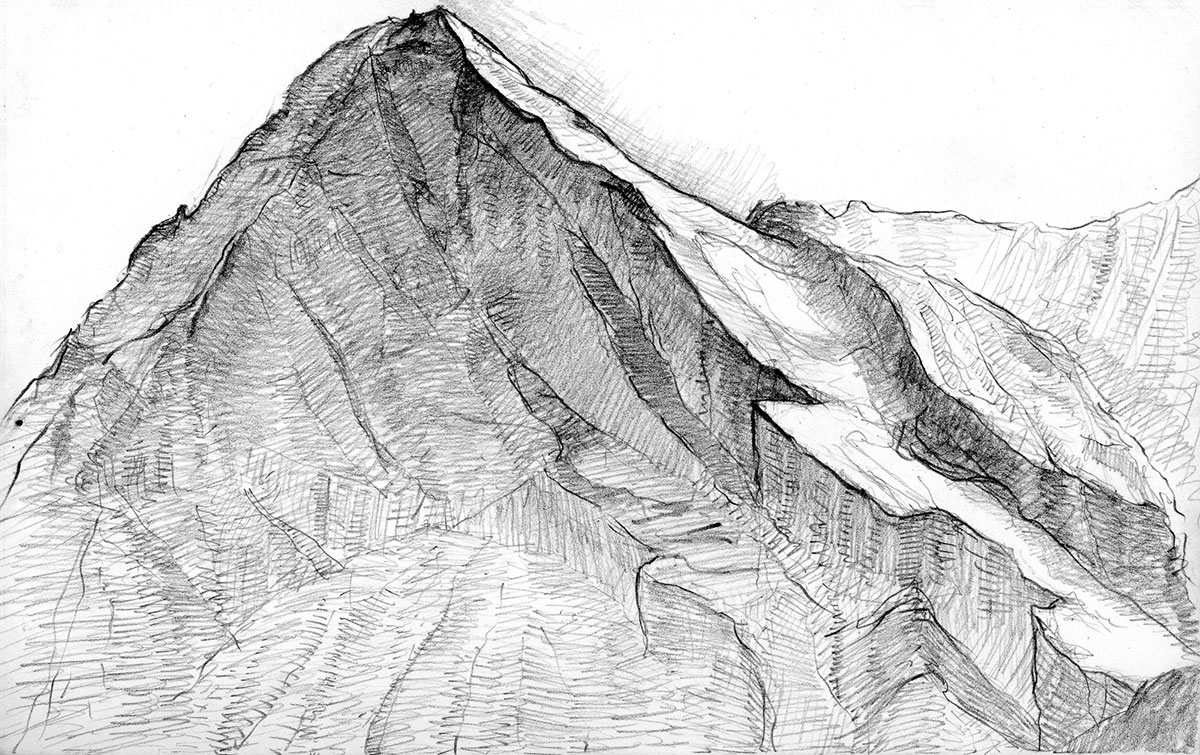Notes on the development of visual ideas

This paper was delivered at the symposium Letter from the east • Carrying, held at the China Academy of Art in Hangzhou, China on 17 December, 2018.
My works in this exhibition consist of a series of drawings I did in the Swiss Alps between July and October of 2018, as well as a two channel video work that resulted from these studies.
Initially, my working method consisted of hiking through the mountains, and stopping to draw interesting land forms. It was important to me that these drawings be done directly and accurately, allowing me to develop a feeling for the geological structures. When not out drawing, I read scientific papers to understand the geological processes by which the mountains were formed, and put together a simple computer model for simulating those processes. In a parallel line of investigation, which I had started prior to my residency in Switzerland, I looked at processes of erosion and collapse in buildings, with a view to connecting that erosion to geological processes of erosion and accretion. The drawings, the reading and the computer models formed the basis for the resulting video work.

Footnotes to Plato
It may seem unconventional, even eccentric, to insist on drawing from direct observation as a preparation for a video work. Furthermore, the resulting work is made entirely on a computer, without the use of a video camera; in fact, the precise forms and the animation in each channel of my video work are generated by programming code. This code models the growth and change of mountains in one channel, and the erosion of built structures in the other: the connecting idea is a sense of our relationship to deep time and the impermanence of even the most seemingly permanent features of our world. So we have an apparent contradiction: on the one hand, a process of direct discovery — what Marcel Duchamp would have dismissed as retinal art — and on the other hand, a work that in an important sense is conceptual. That is, the ideas behind the work and the process of the video work’s development appear to be essential to a proper understanding of it.
So we have an apparent contradiction: on the one hand, a process of direct discovery — what Marcel Duchamp would have dismissed as retinal art — and on the other hand, a work that in an important sense is conceptual
The reason this appears to be a contradiction is due to what I would argue is an almost defining feature of conceptual art: its latent platonism. Duchamp famously privileged the conceptual over the retinal aspects of art, while also recognising that the work of art has to be seen (or at least perceived) in order to exist as a work of art at all.1 There is a clear parallel with Plato’s attack on painters in The Republic, Book 10: Socrates argues that a carpenter, in making a bed, copies the idea of a bed, whereas the painter merely imitates the appearance of a particular bed2. As Plato makes clear, the real bed is the abstract idea or concept of a bed: any particular physical bed is an imperfect copy of this idea, so the painter is, to make matters worse, imitating an imitation. Nowhere in conceptual art is platonism more apparent than in Joseph Kosuth’s One and Three Chairs (1965), which consists of an actual chair, a photo of that chair in the installation space, and a dictionary definition of the word “chair”. The background assumption appears to be that the conceptual work of art is only incidentally perceptual, that the real work of art is the idea itself, floating in some abstract (or at least mental) realm.
The perceptual as conceptual
Suffice it to say that I am not a platonist and I do not accept Duchamp’s privileging of the conceptual over the perceptual. It strikes me as a false dichotomy: as Strawson argued, our perceptions are unavoidably concept-laden, which is to say, our experiences are saturated with prior concepts concerning those objects that we are perceiving. Duchamp acknowledged that the work of art has to be first perceived before one can make sense of its concepts, but of course these perceptions are not pure to start with. It’s as though our perceptions are travellers that arrive with their luggage and travel documents, thereby betraying their origins. The perception is always already what we might properly call a perception-concept. The concept of a work of art therefore cannot be considered independently of its perceptual characteristics.
For these reasons, my process for developing a work is both perceptual and conceptual. In choosing the Alps as a subject, I had certain prior ideas concerning our place in geological time; I had formulated these ideas, these concepts, in response to my experiences in the ancient Pilbara region of Western Australia. Drawing from observation forces me to come to terms with what I am looking at: the subsequent ideas arise both out of the subjective sense of this experience, and the ideas which I have carried with me to that experience. Further research into the geological processes that formed the Alps both better informed my drawings and enabled me to perceive more — to draw the mountains better. The deeper background knowledge, paired with findings from the observational drawings, in turn gave me a foundation for the development of the video work. My work is the result of this iterative, exploratory process.
- Furlong, W (ed.) 2010, Speaking of Art, Phaidon, London, p. 16.
- The Republic, trans. G Grube rev. C Reeve, in Cooper, J (ed.) 1997, Plato: Complete Works, Hackett, Indianapolis, pp. 1200–1203.
